Analysis of Consumer Behaviour and Insights in the Marketing Context
VerifiedAdded on 2022/11/29
|15
|3452
|373
Report
AI Summary
This report delves into the intricacies of consumer behavior and decision-making processes, providing a comprehensive analysis of the stages involved in consumer choices, from need recognition to post-purchase behavior. It examines the significance of understanding consumer insights for marketers, emphasizing the importance of mapping consumer journeys to adapt to dynamic market trends and personalize customer experiences. The report contrasts the decision-making processes in B2C and B2B marketing, highlighting key differences in communication, research methods, and sample sizes. It evaluates various factors influencing buying behavior, such as culture, and assesses how marketers can effectively impact each stage of the decision-making process through strategic interventions and research methodologies. The analysis also provides a case study of Unilever, a multinational corporation, to illustrate real-world applications of these concepts.

Consumer behaviour and
insights.
insights.
Paraphrase This Document
Need a fresh take? Get an instant paraphrase of this document with our AI Paraphraser
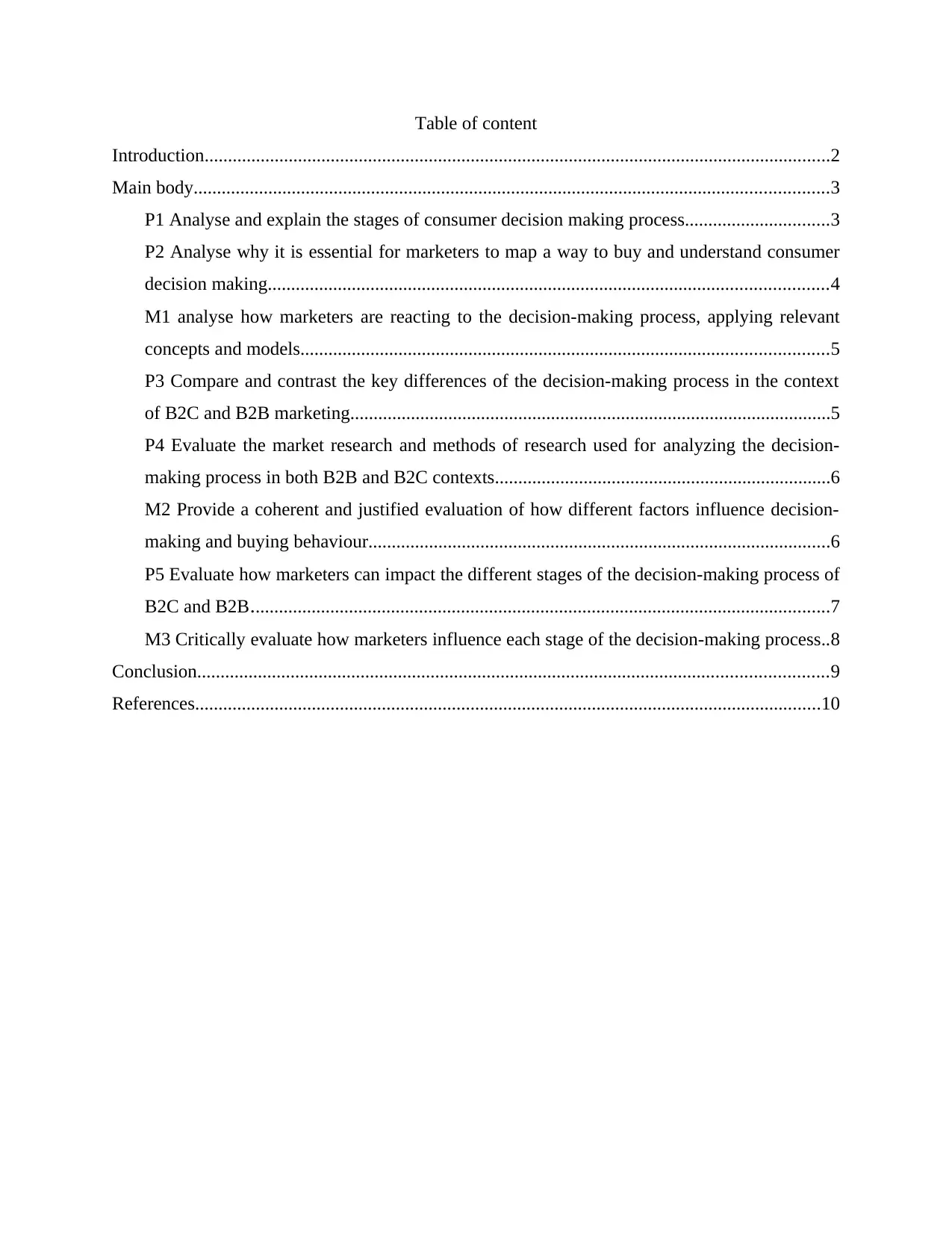
Table of content
Introduction......................................................................................................................................2
Main body........................................................................................................................................3
P1 Analyse and explain the stages of consumer decision making process...............................3
P2 Analyse why it is essential for marketers to map a way to buy and understand consumer
decision making........................................................................................................................4
M1 analyse how marketers are reacting to the decision-making process, applying relevant
concepts and models.................................................................................................................5
P3 Compare and contrast the key differences of the decision-making process in the context
of B2C and B2B marketing.......................................................................................................5
P4 Evaluate the market research and methods of research used for analyzing the decision-
making process in both B2B and B2C contexts........................................................................6
M2 Provide a coherent and justified evaluation of how different factors influence decision-
making and buying behaviour...................................................................................................6
P5 Evaluate how marketers can impact the different stages of the decision-making process of
B2C and B2B............................................................................................................................7
M3 Critically evaluate how marketers influence each stage of the decision-making process..8
Conclusion.......................................................................................................................................9
References......................................................................................................................................10
Introduction......................................................................................................................................2
Main body........................................................................................................................................3
P1 Analyse and explain the stages of consumer decision making process...............................3
P2 Analyse why it is essential for marketers to map a way to buy and understand consumer
decision making........................................................................................................................4
M1 analyse how marketers are reacting to the decision-making process, applying relevant
concepts and models.................................................................................................................5
P3 Compare and contrast the key differences of the decision-making process in the context
of B2C and B2B marketing.......................................................................................................5
P4 Evaluate the market research and methods of research used for analyzing the decision-
making process in both B2B and B2C contexts........................................................................6
M2 Provide a coherent and justified evaluation of how different factors influence decision-
making and buying behaviour...................................................................................................6
P5 Evaluate how marketers can impact the different stages of the decision-making process of
B2C and B2B............................................................................................................................7
M3 Critically evaluate how marketers influence each stage of the decision-making process..8
Conclusion.......................................................................................................................................9
References......................................................................................................................................10
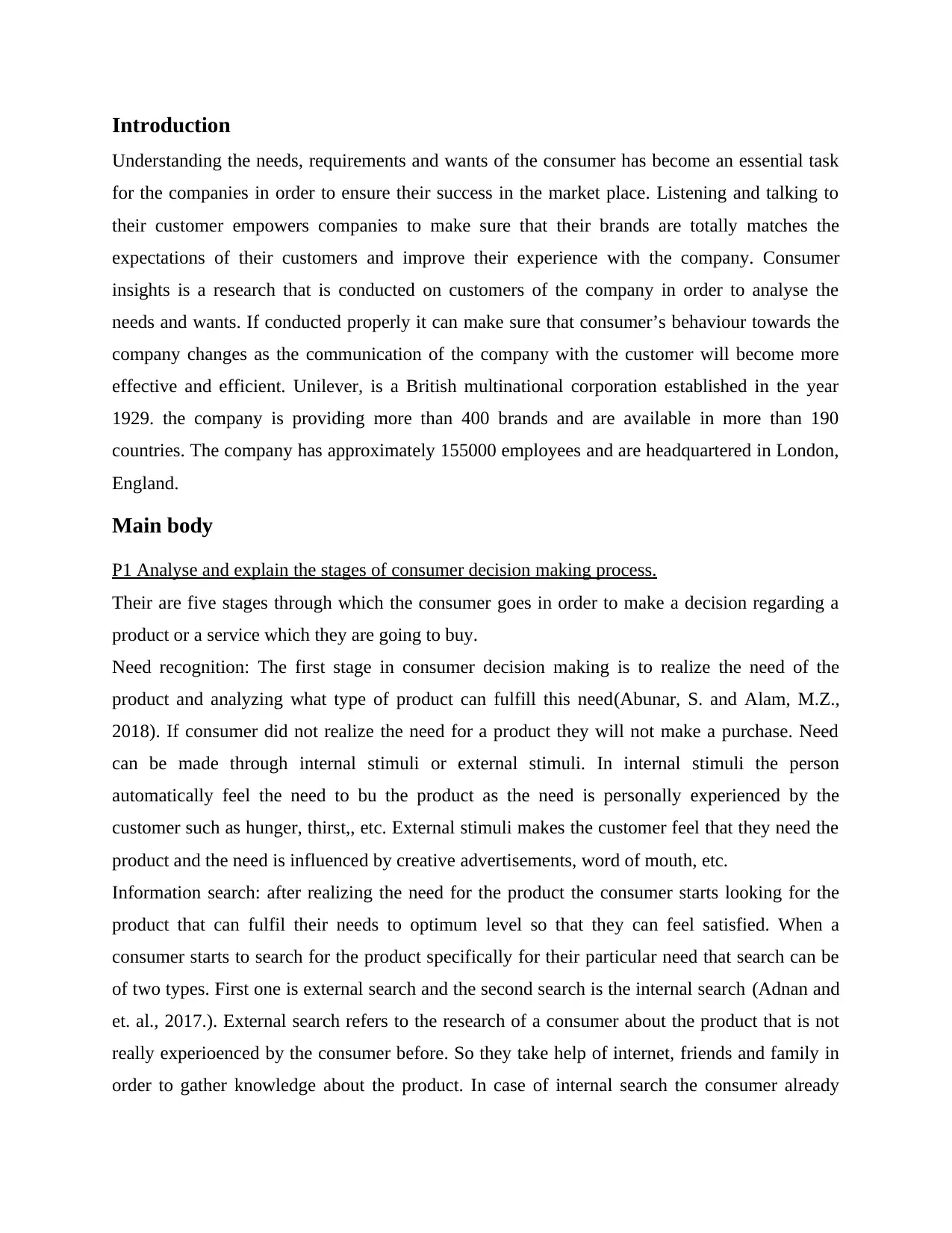
Introduction
Understanding the needs, requirements and wants of the consumer has become an essential task
for the companies in order to ensure their success in the market place. Listening and talking to
their customer empowers companies to make sure that their brands are totally matches the
expectations of their customers and improve their experience with the company. Consumer
insights is a research that is conducted on customers of the company in order to analyse the
needs and wants. If conducted properly it can make sure that consumer’s behaviour towards the
company changes as the communication of the company with the customer will become more
effective and efficient. Unilever, is a British multinational corporation established in the year
1929. the company is providing more than 400 brands and are available in more than 190
countries. The company has approximately 155000 employees and are headquartered in London,
England.
Main body
P1 Analyse and explain the stages of consumer decision making process.
Their are five stages through which the consumer goes in order to make a decision regarding a
product or a service which they are going to buy.
Need recognition: The first stage in consumer decision making is to realize the need of the
product and analyzing what type of product can fulfill this need(Abunar, S. and Alam, M.Z.,
2018). If consumer did not realize the need for a product they will not make a purchase. Need
can be made through internal stimuli or external stimuli. In internal stimuli the person
automatically feel the need to bu the product as the need is personally experienced by the
customer such as hunger, thirst,, etc. External stimuli makes the customer feel that they need the
product and the need is influenced by creative advertisements, word of mouth, etc.
Information search: after realizing the need for the product the consumer starts looking for the
product that can fulfil their needs to optimum level so that they can feel satisfied. When a
consumer starts to search for the product specifically for their particular need that search can be
of two types. First one is external search and the second search is the internal search (Adnan and
et. al., 2017.). External search refers to the research of a consumer about the product that is not
really experioenced by the consumer before. So they take help of internet, friends and family in
order to gather knowledge about the product. In case of internal search the consumer already
Understanding the needs, requirements and wants of the consumer has become an essential task
for the companies in order to ensure their success in the market place. Listening and talking to
their customer empowers companies to make sure that their brands are totally matches the
expectations of their customers and improve their experience with the company. Consumer
insights is a research that is conducted on customers of the company in order to analyse the
needs and wants. If conducted properly it can make sure that consumer’s behaviour towards the
company changes as the communication of the company with the customer will become more
effective and efficient. Unilever, is a British multinational corporation established in the year
1929. the company is providing more than 400 brands and are available in more than 190
countries. The company has approximately 155000 employees and are headquartered in London,
England.
Main body
P1 Analyse and explain the stages of consumer decision making process.
Their are five stages through which the consumer goes in order to make a decision regarding a
product or a service which they are going to buy.
Need recognition: The first stage in consumer decision making is to realize the need of the
product and analyzing what type of product can fulfill this need(Abunar, S. and Alam, M.Z.,
2018). If consumer did not realize the need for a product they will not make a purchase. Need
can be made through internal stimuli or external stimuli. In internal stimuli the person
automatically feel the need to bu the product as the need is personally experienced by the
customer such as hunger, thirst,, etc. External stimuli makes the customer feel that they need the
product and the need is influenced by creative advertisements, word of mouth, etc.
Information search: after realizing the need for the product the consumer starts looking for the
product that can fulfil their needs to optimum level so that they can feel satisfied. When a
consumer starts to search for the product specifically for their particular need that search can be
of two types. First one is external search and the second search is the internal search (Adnan and
et. al., 2017.). External search refers to the research of a consumer about the product that is not
really experioenced by the consumer before. So they take help of internet, friends and family in
order to gather knowledge about the product. In case of internal search the consumer already
⊘ This is a preview!⊘
Do you want full access?
Subscribe today to unlock all pages.

Trusted by 1+ million students worldwide
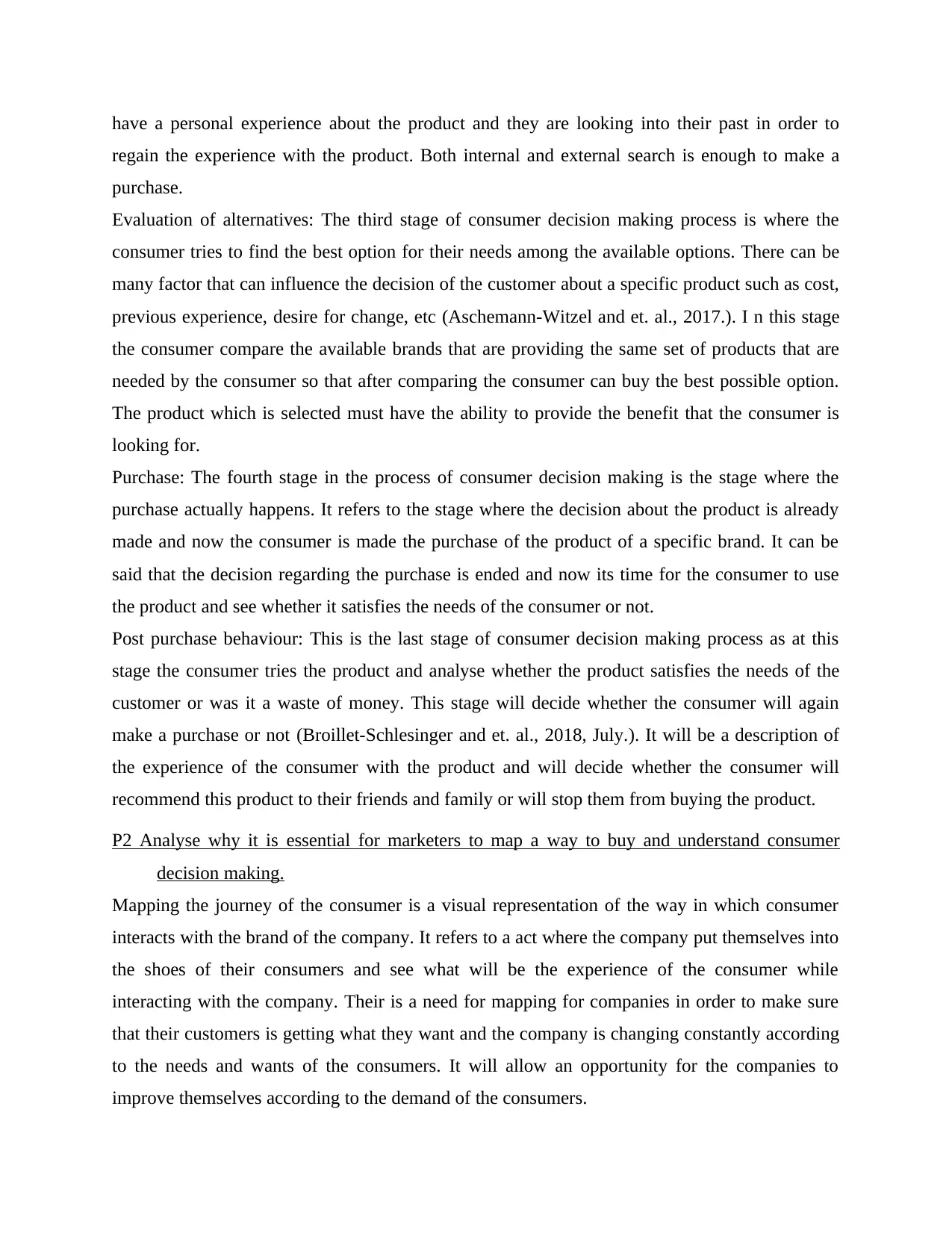
have a personal experience about the product and they are looking into their past in order to
regain the experience with the product. Both internal and external search is enough to make a
purchase.
Evaluation of alternatives: The third stage of consumer decision making process is where the
consumer tries to find the best option for their needs among the available options. There can be
many factor that can influence the decision of the customer about a specific product such as cost,
previous experience, desire for change, etc (Aschemann-Witzel and et. al., 2017.). I n this stage
the consumer compare the available brands that are providing the same set of products that are
needed by the consumer so that after comparing the consumer can buy the best possible option.
The product which is selected must have the ability to provide the benefit that the consumer is
looking for.
Purchase: The fourth stage in the process of consumer decision making is the stage where the
purchase actually happens. It refers to the stage where the decision about the product is already
made and now the consumer is made the purchase of the product of a specific brand. It can be
said that the decision regarding the purchase is ended and now its time for the consumer to use
the product and see whether it satisfies the needs of the consumer or not.
Post purchase behaviour: This is the last stage of consumer decision making process as at this
stage the consumer tries the product and analyse whether the product satisfies the needs of the
customer or was it a waste of money. This stage will decide whether the consumer will again
make a purchase or not (Broillet-Schlesinger and et. al., 2018, July.). It will be a description of
the experience of the consumer with the product and will decide whether the consumer will
recommend this product to their friends and family or will stop them from buying the product.
P2 Analyse why it is essential for marketers to map a way to buy and understand consumer
decision making.
Mapping the journey of the consumer is a visual representation of the way in which consumer
interacts with the brand of the company. It refers to a act where the company put themselves into
the shoes of their consumers and see what will be the experience of the consumer while
interacting with the company. Their is a need for mapping for companies in order to make sure
that their customers is getting what they want and the company is changing constantly according
to the needs and wants of the consumers. It will allow an opportunity for the companies to
improve themselves according to the demand of the consumers.
regain the experience with the product. Both internal and external search is enough to make a
purchase.
Evaluation of alternatives: The third stage of consumer decision making process is where the
consumer tries to find the best option for their needs among the available options. There can be
many factor that can influence the decision of the customer about a specific product such as cost,
previous experience, desire for change, etc (Aschemann-Witzel and et. al., 2017.). I n this stage
the consumer compare the available brands that are providing the same set of products that are
needed by the consumer so that after comparing the consumer can buy the best possible option.
The product which is selected must have the ability to provide the benefit that the consumer is
looking for.
Purchase: The fourth stage in the process of consumer decision making is the stage where the
purchase actually happens. It refers to the stage where the decision about the product is already
made and now the consumer is made the purchase of the product of a specific brand. It can be
said that the decision regarding the purchase is ended and now its time for the consumer to use
the product and see whether it satisfies the needs of the consumer or not.
Post purchase behaviour: This is the last stage of consumer decision making process as at this
stage the consumer tries the product and analyse whether the product satisfies the needs of the
customer or was it a waste of money. This stage will decide whether the consumer will again
make a purchase or not (Broillet-Schlesinger and et. al., 2018, July.). It will be a description of
the experience of the consumer with the product and will decide whether the consumer will
recommend this product to their friends and family or will stop them from buying the product.
P2 Analyse why it is essential for marketers to map a way to buy and understand consumer
decision making.
Mapping the journey of the consumer is a visual representation of the way in which consumer
interacts with the brand of the company. It refers to a act where the company put themselves into
the shoes of their consumers and see what will be the experience of the consumer while
interacting with the company. Their is a need for mapping for companies in order to make sure
that their customers is getting what they want and the company is changing constantly according
to the needs and wants of the consumers. It will allow an opportunity for the companies to
improve themselves according to the demand of the consumers.
Paraphrase This Document
Need a fresh take? Get an instant paraphrase of this document with our AI Paraphraser

Changing expectations of consumers: Their is a need for marketers to do mapping as the market
nowadays are highly dynamic and their is a need for constant upgradation in the products and
services of the company so that they can cope up with the market and can deliver the products
and services according to the needs and demands of the consumers.
Personalized experience: According to a survey their is about 80 percent of consumers states that
they will likely to buy products from the brands that provide personalized experience. It is in
demand and is a necessity for companies to provide personalized products so that they can
capture a big segment of the market and can make sure that people are happy with the experience
(Kagita, N., 2017.). In order to provide personalized experience the company needs to do
mapping of the customers journey so that they can get some insights about the preferences of the
consumers and can suggest products accordingly.
M1 analyse how marketers are reacting to the decision-making process, applying relevant
concepts and models
It is important for the marketers to respond correctly and quickly to the decision making process
of the consumer. It can make the marketer aware of the trends and will also help them in
marketing their products in a way so that they can create a need for their products in the lives of
their potential customers (Lima and et. al., 2018.). The marketer needs to make sure that their
products can fulfill the needs and wants of the customers and are able to satisfy them so that they
can recommend the product to their family and friends and can also make sure that the consumer
is spreading a good word of mouth for the product.
P3 Compare and contrast the key differences of the decision-making process in the context of
B2C and B2B marketing.
B2B Maintain open communication: In between business to business, the decision making
process is an open communication as both the businesses focuses on the fact that how the
product of one company can help the other company in their business. They have a mindset pf
earning profit and rely on that only. Both the companies can discuss the positive aspects of the
product and how it can help the management of other company. During the decision making
process of business to business marketing the B2B customers must evaluate the need of their
company as well as of their workers. In order to do so their needs can be separated in two
different motivations that is rational and emotional. In rational motivation the company thinks
nowadays are highly dynamic and their is a need for constant upgradation in the products and
services of the company so that they can cope up with the market and can deliver the products
and services according to the needs and demands of the consumers.
Personalized experience: According to a survey their is about 80 percent of consumers states that
they will likely to buy products from the brands that provide personalized experience. It is in
demand and is a necessity for companies to provide personalized products so that they can
capture a big segment of the market and can make sure that people are happy with the experience
(Kagita, N., 2017.). In order to provide personalized experience the company needs to do
mapping of the customers journey so that they can get some insights about the preferences of the
consumers and can suggest products accordingly.
M1 analyse how marketers are reacting to the decision-making process, applying relevant
concepts and models
It is important for the marketers to respond correctly and quickly to the decision making process
of the consumer. It can make the marketer aware of the trends and will also help them in
marketing their products in a way so that they can create a need for their products in the lives of
their potential customers (Lima and et. al., 2018.). The marketer needs to make sure that their
products can fulfill the needs and wants of the customers and are able to satisfy them so that they
can recommend the product to their family and friends and can also make sure that the consumer
is spreading a good word of mouth for the product.
P3 Compare and contrast the key differences of the decision-making process in the context of
B2C and B2B marketing.
B2B Maintain open communication: In between business to business, the decision making
process is an open communication as both the businesses focuses on the fact that how the
product of one company can help the other company in their business. They have a mindset pf
earning profit and rely on that only. Both the companies can discuss the positive aspects of the
product and how it can help the management of other company. During the decision making
process of business to business marketing the B2B customers must evaluate the need of their
company as well as of their workers. In order to do so their needs can be separated in two
different motivations that is rational and emotional. In rational motivation the company thinks
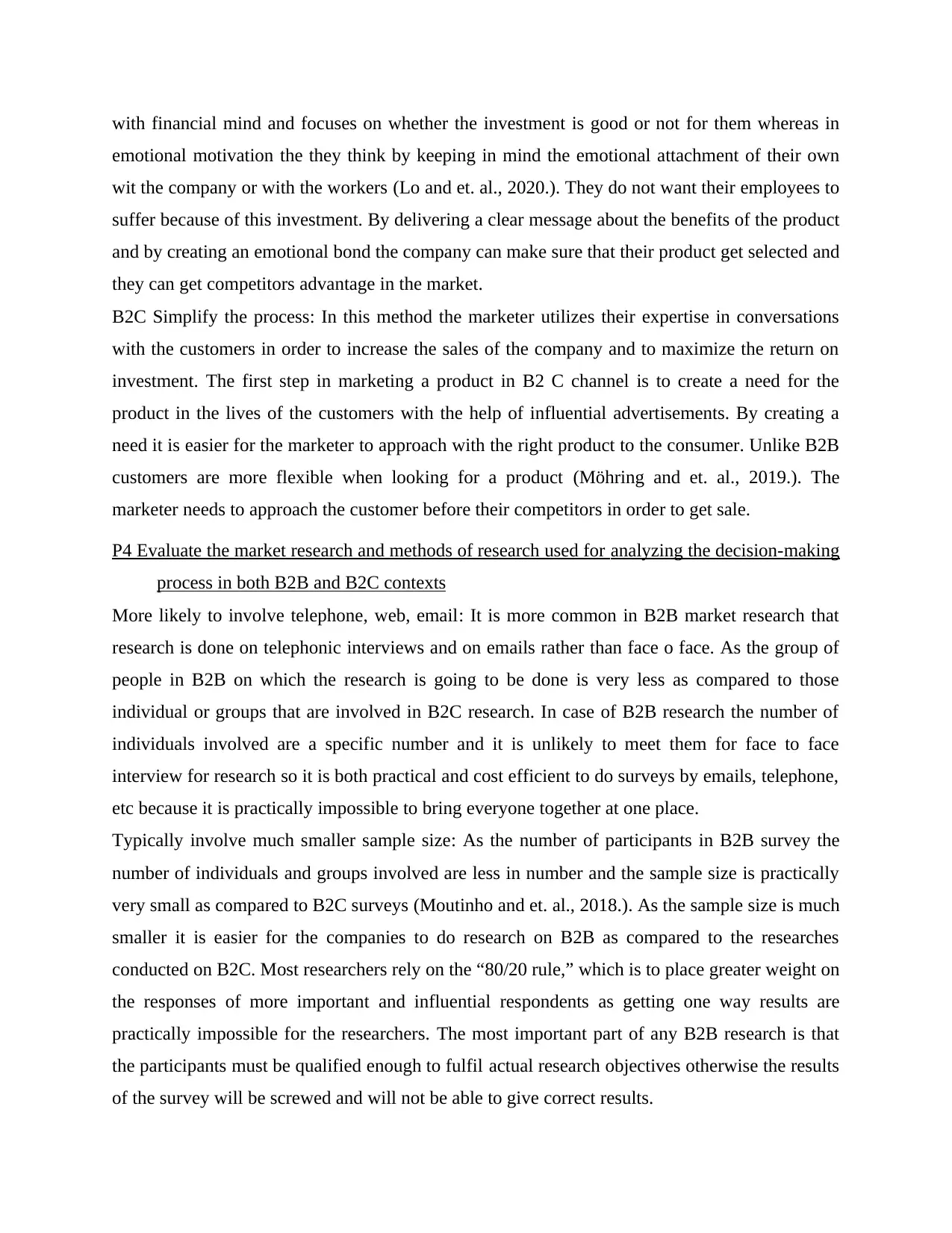
with financial mind and focuses on whether the investment is good or not for them whereas in
emotional motivation the they think by keeping in mind the emotional attachment of their own
wit the company or with the workers (Lo and et. al., 2020.). They do not want their employees to
suffer because of this investment. By delivering a clear message about the benefits of the product
and by creating an emotional bond the company can make sure that their product get selected and
they can get competitors advantage in the market.
B2C Simplify the process: In this method the marketer utilizes their expertise in conversations
with the customers in order to increase the sales of the company and to maximize the return on
investment. The first step in marketing a product in B2 C channel is to create a need for the
product in the lives of the customers with the help of influential advertisements. By creating a
need it is easier for the marketer to approach with the right product to the consumer. Unlike B2B
customers are more flexible when looking for a product (Möhring and et. al., 2019.). The
marketer needs to approach the customer before their competitors in order to get sale.
P4 Evaluate the market research and methods of research used for analyzing the decision-making
process in both B2B and B2C contexts
More likely to involve telephone, web, email: It is more common in B2B market research that
research is done on telephonic interviews and on emails rather than face o face. As the group of
people in B2B on which the research is going to be done is very less as compared to those
individual or groups that are involved in B2C research. In case of B2B research the number of
individuals involved are a specific number and it is unlikely to meet them for face to face
interview for research so it is both practical and cost efficient to do surveys by emails, telephone,
etc because it is practically impossible to bring everyone together at one place.
Typically involve much smaller sample size: As the number of participants in B2B survey the
number of individuals and groups involved are less in number and the sample size is practically
very small as compared to B2C surveys (Moutinho and et. al., 2018.). As the sample size is much
smaller it is easier for the companies to do research on B2B as compared to the researches
conducted on B2C. Most researchers rely on the “80/20 rule,” which is to place greater weight on
the responses of more important and influential respondents as getting one way results are
practically impossible for the researchers. The most important part of any B2B research is that
the participants must be qualified enough to fulfil actual research objectives otherwise the results
of the survey will be screwed and will not be able to give correct results.
emotional motivation the they think by keeping in mind the emotional attachment of their own
wit the company or with the workers (Lo and et. al., 2020.). They do not want their employees to
suffer because of this investment. By delivering a clear message about the benefits of the product
and by creating an emotional bond the company can make sure that their product get selected and
they can get competitors advantage in the market.
B2C Simplify the process: In this method the marketer utilizes their expertise in conversations
with the customers in order to increase the sales of the company and to maximize the return on
investment. The first step in marketing a product in B2 C channel is to create a need for the
product in the lives of the customers with the help of influential advertisements. By creating a
need it is easier for the marketer to approach with the right product to the consumer. Unlike B2B
customers are more flexible when looking for a product (Möhring and et. al., 2019.). The
marketer needs to approach the customer before their competitors in order to get sale.
P4 Evaluate the market research and methods of research used for analyzing the decision-making
process in both B2B and B2C contexts
More likely to involve telephone, web, email: It is more common in B2B market research that
research is done on telephonic interviews and on emails rather than face o face. As the group of
people in B2B on which the research is going to be done is very less as compared to those
individual or groups that are involved in B2C research. In case of B2B research the number of
individuals involved are a specific number and it is unlikely to meet them for face to face
interview for research so it is both practical and cost efficient to do surveys by emails, telephone,
etc because it is practically impossible to bring everyone together at one place.
Typically involve much smaller sample size: As the number of participants in B2B survey the
number of individuals and groups involved are less in number and the sample size is practically
very small as compared to B2C surveys (Moutinho and et. al., 2018.). As the sample size is much
smaller it is easier for the companies to do research on B2B as compared to the researches
conducted on B2C. Most researchers rely on the “80/20 rule,” which is to place greater weight on
the responses of more important and influential respondents as getting one way results are
practically impossible for the researchers. The most important part of any B2B research is that
the participants must be qualified enough to fulfil actual research objectives otherwise the results
of the survey will be screwed and will not be able to give correct results.
⊘ This is a preview!⊘
Do you want full access?
Subscribe today to unlock all pages.

Trusted by 1+ million students worldwide
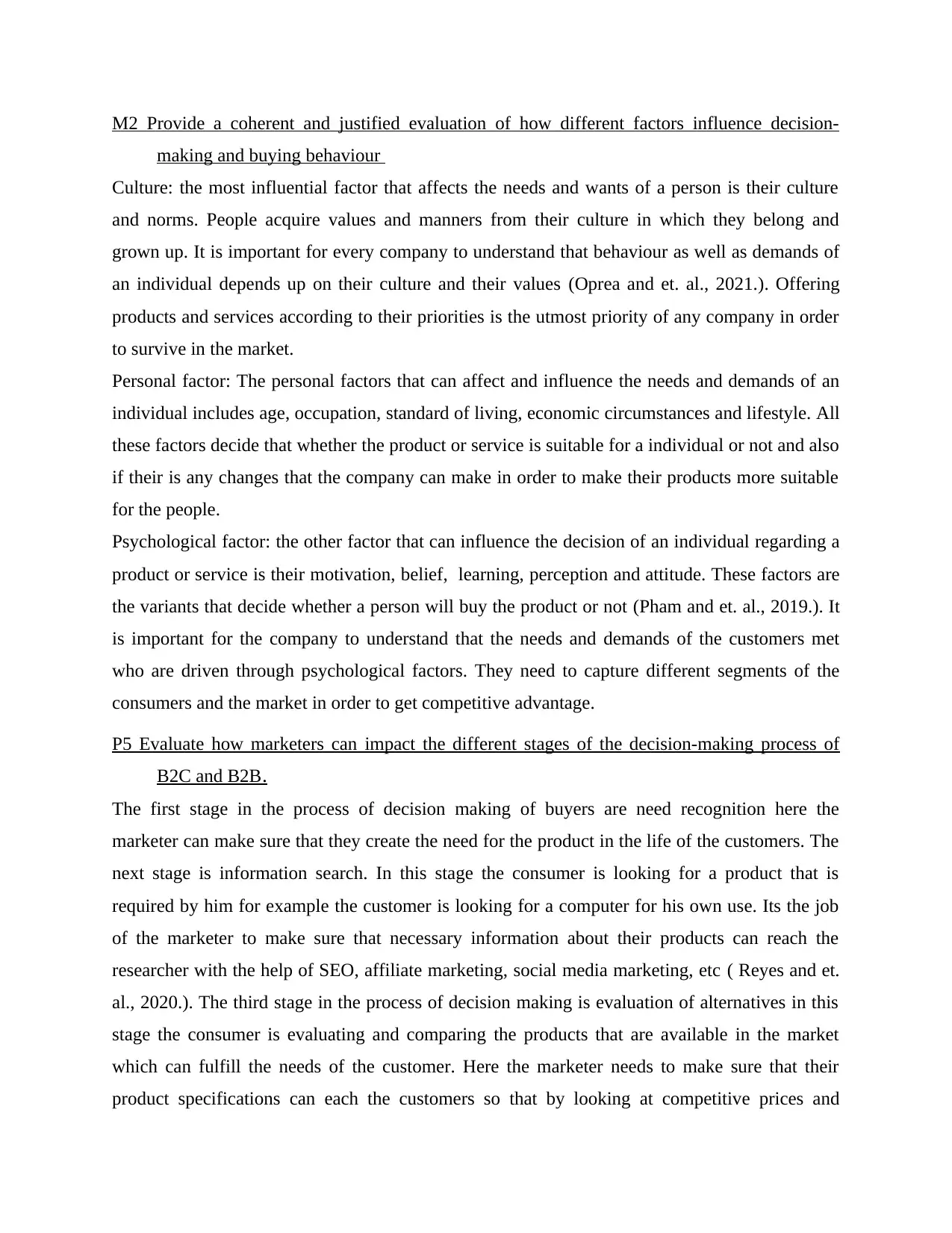
M2 Provide a coherent and justified evaluation of how different factors influence decision-
making and buying behaviour
Culture: the most influential factor that affects the needs and wants of a person is their culture
and norms. People acquire values and manners from their culture in which they belong and
grown up. It is important for every company to understand that behaviour as well as demands of
an individual depends up on their culture and their values (Oprea and et. al., 2021.). Offering
products and services according to their priorities is the utmost priority of any company in order
to survive in the market.
Personal factor: The personal factors that can affect and influence the needs and demands of an
individual includes age, occupation, standard of living, economic circumstances and lifestyle. All
these factors decide that whether the product or service is suitable for a individual or not and also
if their is any changes that the company can make in order to make their products more suitable
for the people.
Psychological factor: the other factor that can influence the decision of an individual regarding a
product or service is their motivation, belief, learning, perception and attitude. These factors are
the variants that decide whether a person will buy the product or not (Pham and et. al., 2019.). It
is important for the company to understand that the needs and demands of the customers met
who are driven through psychological factors. They need to capture different segments of the
consumers and the market in order to get competitive advantage.
P5 Evaluate how marketers can impact the different stages of the decision-making process of
B2C and B2B.
The first stage in the process of decision making of buyers are need recognition here the
marketer can make sure that they create the need for the product in the life of the customers. The
next stage is information search. In this stage the consumer is looking for a product that is
required by him for example the customer is looking for a computer for his own use. Its the job
of the marketer to make sure that necessary information about their products can reach the
researcher with the help of SEO, affiliate marketing, social media marketing, etc ( Reyes and et.
al., 2020.). The third stage in the process of decision making is evaluation of alternatives in this
stage the consumer is evaluating and comparing the products that are available in the market
which can fulfill the needs of the customer. Here the marketer needs to make sure that their
product specifications can each the customers so that by looking at competitive prices and
making and buying behaviour
Culture: the most influential factor that affects the needs and wants of a person is their culture
and norms. People acquire values and manners from their culture in which they belong and
grown up. It is important for every company to understand that behaviour as well as demands of
an individual depends up on their culture and their values (Oprea and et. al., 2021.). Offering
products and services according to their priorities is the utmost priority of any company in order
to survive in the market.
Personal factor: The personal factors that can affect and influence the needs and demands of an
individual includes age, occupation, standard of living, economic circumstances and lifestyle. All
these factors decide that whether the product or service is suitable for a individual or not and also
if their is any changes that the company can make in order to make their products more suitable
for the people.
Psychological factor: the other factor that can influence the decision of an individual regarding a
product or service is their motivation, belief, learning, perception and attitude. These factors are
the variants that decide whether a person will buy the product or not (Pham and et. al., 2019.). It
is important for the company to understand that the needs and demands of the customers met
who are driven through psychological factors. They need to capture different segments of the
consumers and the market in order to get competitive advantage.
P5 Evaluate how marketers can impact the different stages of the decision-making process of
B2C and B2B.
The first stage in the process of decision making of buyers are need recognition here the
marketer can make sure that they create the need for the product in the life of the customers. The
next stage is information search. In this stage the consumer is looking for a product that is
required by him for example the customer is looking for a computer for his own use. Its the job
of the marketer to make sure that necessary information about their products can reach the
researcher with the help of SEO, affiliate marketing, social media marketing, etc ( Reyes and et.
al., 2020.). The third stage in the process of decision making is evaluation of alternatives in this
stage the consumer is evaluating and comparing the products that are available in the market
which can fulfill the needs of the customer. Here the marketer needs to make sure that their
product specifications can each the customers so that by looking at competitive prices and
Paraphrase This Document
Need a fresh take? Get an instant paraphrase of this document with our AI Paraphraser
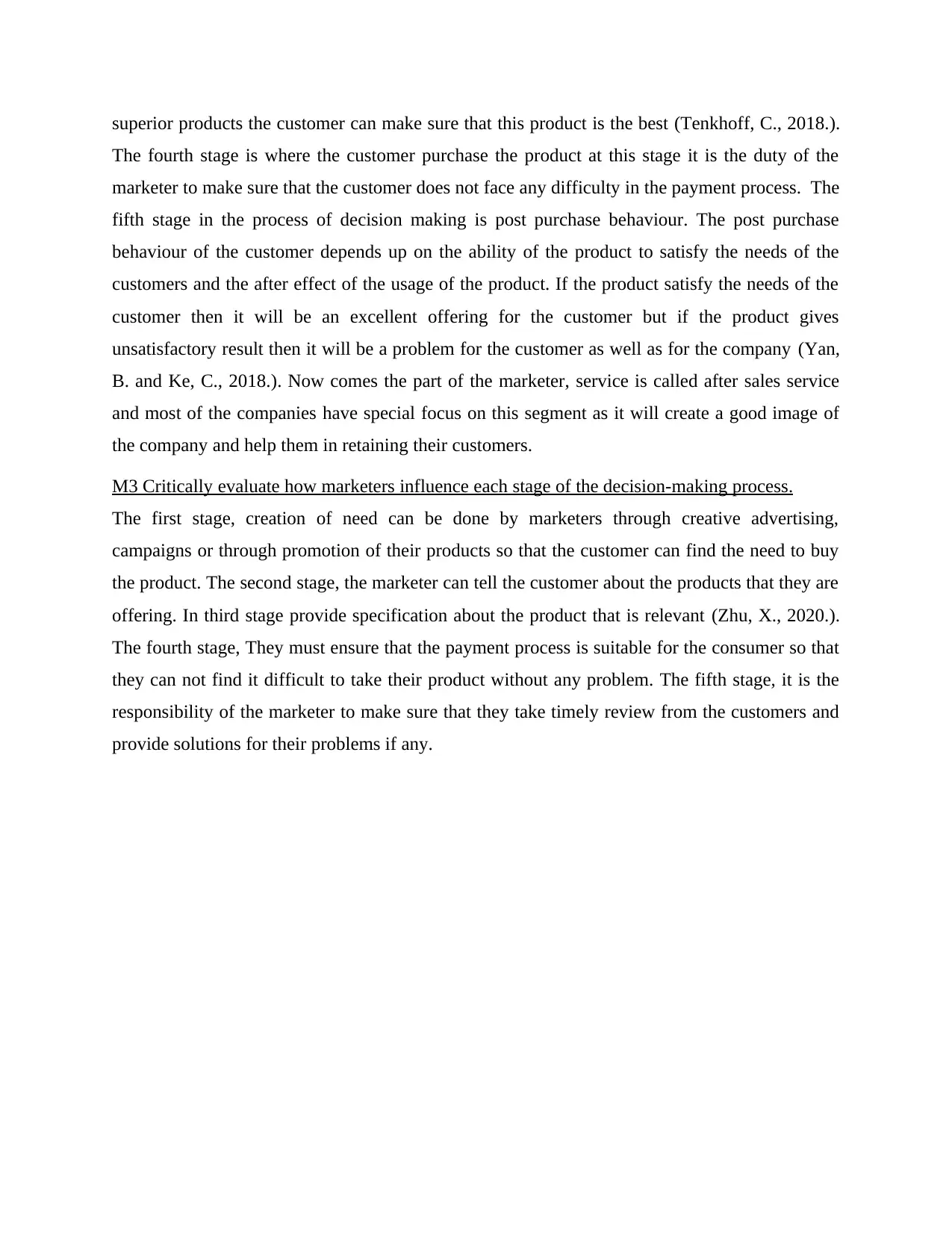
superior products the customer can make sure that this product is the best (Tenkhoff, C., 2018.).
The fourth stage is where the customer purchase the product at this stage it is the duty of the
marketer to make sure that the customer does not face any difficulty in the payment process. The
fifth stage in the process of decision making is post purchase behaviour. The post purchase
behaviour of the customer depends up on the ability of the product to satisfy the needs of the
customers and the after effect of the usage of the product. If the product satisfy the needs of the
customer then it will be an excellent offering for the customer but if the product gives
unsatisfactory result then it will be a problem for the customer as well as for the company (Yan,
B. and Ke, C., 2018.). Now comes the part of the marketer, service is called after sales service
and most of the companies have special focus on this segment as it will create a good image of
the company and help them in retaining their customers.
M3 Critically evaluate how marketers influence each stage of the decision-making process.
The first stage, creation of need can be done by marketers through creative advertising,
campaigns or through promotion of their products so that the customer can find the need to buy
the product. The second stage, the marketer can tell the customer about the products that they are
offering. In third stage provide specification about the product that is relevant (Zhu, X., 2020.).
The fourth stage, They must ensure that the payment process is suitable for the consumer so that
they can not find it difficult to take their product without any problem. The fifth stage, it is the
responsibility of the marketer to make sure that they take timely review from the customers and
provide solutions for their problems if any.
The fourth stage is where the customer purchase the product at this stage it is the duty of the
marketer to make sure that the customer does not face any difficulty in the payment process. The
fifth stage in the process of decision making is post purchase behaviour. The post purchase
behaviour of the customer depends up on the ability of the product to satisfy the needs of the
customers and the after effect of the usage of the product. If the product satisfy the needs of the
customer then it will be an excellent offering for the customer but if the product gives
unsatisfactory result then it will be a problem for the customer as well as for the company (Yan,
B. and Ke, C., 2018.). Now comes the part of the marketer, service is called after sales service
and most of the companies have special focus on this segment as it will create a good image of
the company and help them in retaining their customers.
M3 Critically evaluate how marketers influence each stage of the decision-making process.
The first stage, creation of need can be done by marketers through creative advertising,
campaigns or through promotion of their products so that the customer can find the need to buy
the product. The second stage, the marketer can tell the customer about the products that they are
offering. In third stage provide specification about the product that is relevant (Zhu, X., 2020.).
The fourth stage, They must ensure that the payment process is suitable for the consumer so that
they can not find it difficult to take their product without any problem. The fifth stage, it is the
responsibility of the marketer to make sure that they take timely review from the customers and
provide solutions for their problems if any.
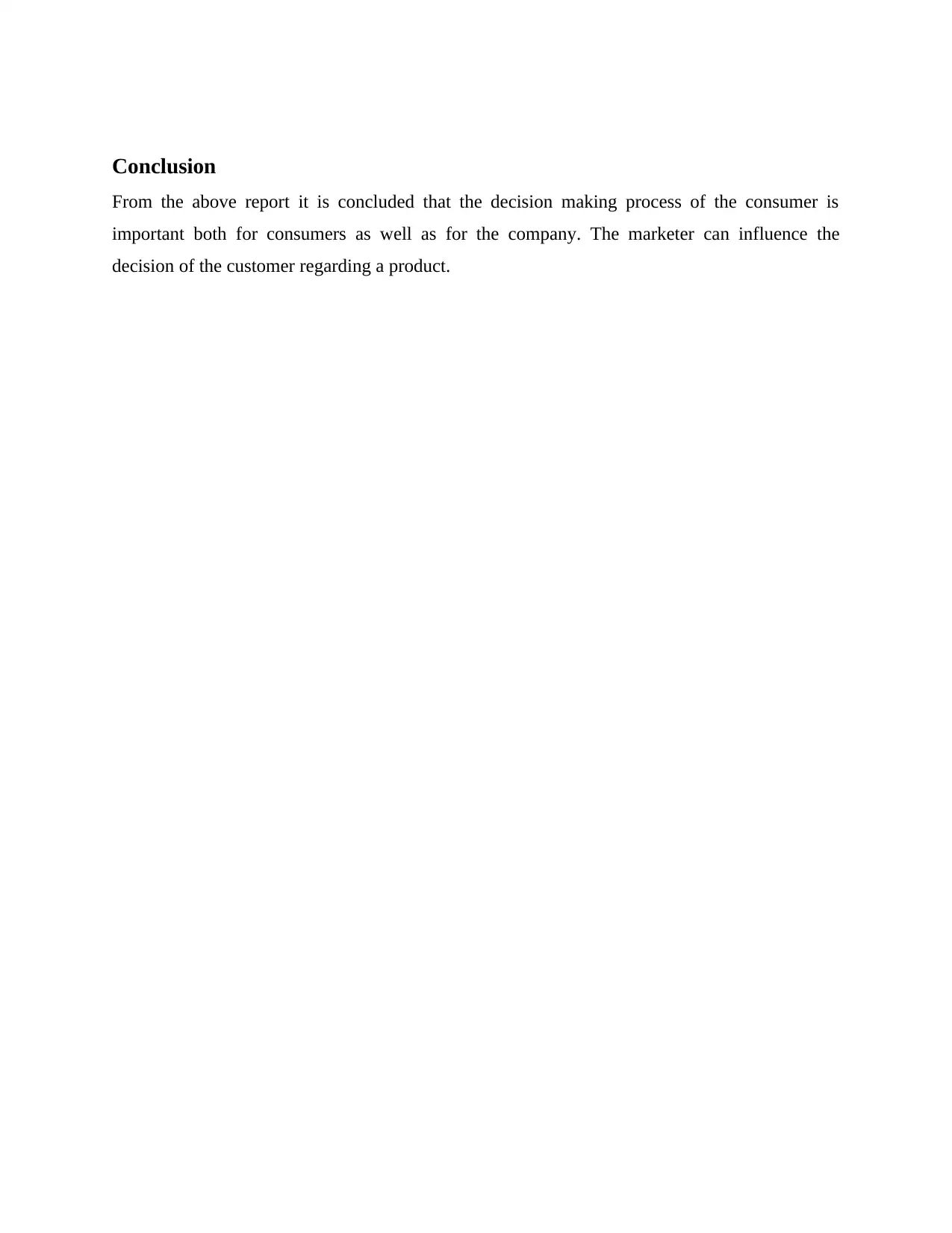
Conclusion
From the above report it is concluded that the decision making process of the consumer is
important both for consumers as well as for the company. The marketer can influence the
decision of the customer regarding a product.
From the above report it is concluded that the decision making process of the consumer is
important both for consumers as well as for the company. The marketer can influence the
decision of the customer regarding a product.
⊘ This is a preview!⊘
Do you want full access?
Subscribe today to unlock all pages.

Trusted by 1+ million students worldwide
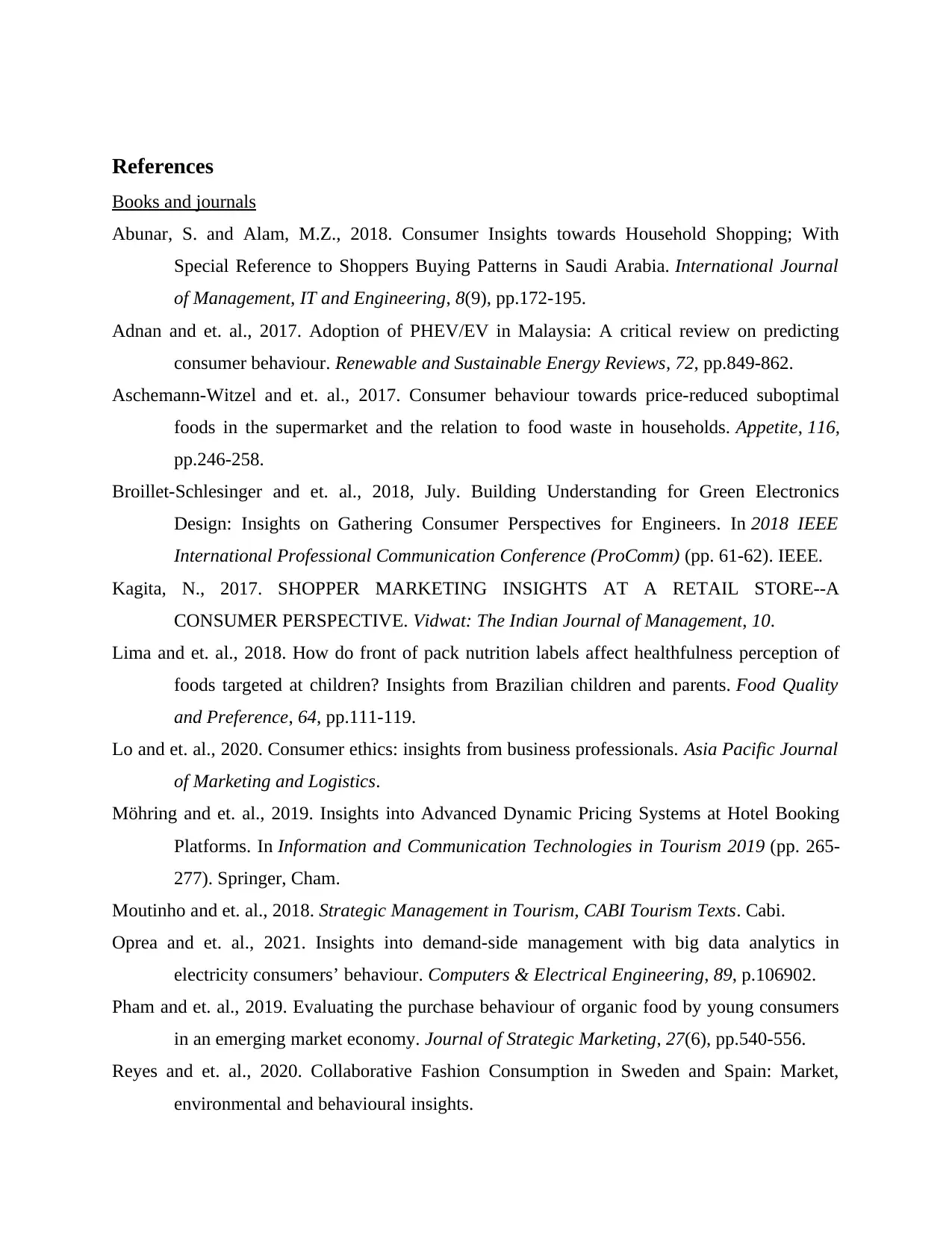
References
Books and journals
Abunar, S. and Alam, M.Z., 2018. Consumer Insights towards Household Shopping; With
Special Reference to Shoppers Buying Patterns in Saudi Arabia. International Journal
of Management, IT and Engineering, 8(9), pp.172-195.
Adnan and et. al., 2017. Adoption of PHEV/EV in Malaysia: A critical review on predicting
consumer behaviour. Renewable and Sustainable Energy Reviews, 72, pp.849-862.
Aschemann-Witzel and et. al., 2017. Consumer behaviour towards price-reduced suboptimal
foods in the supermarket and the relation to food waste in households. Appetite, 116,
pp.246-258.
Broillet-Schlesinger and et. al., 2018, July. Building Understanding for Green Electronics
Design: Insights on Gathering Consumer Perspectives for Engineers. In 2018 IEEE
International Professional Communication Conference (ProComm) (pp. 61-62). IEEE.
Kagita, N., 2017. SHOPPER MARKETING INSIGHTS AT A RETAIL STORE--A
CONSUMER PERSPECTIVE. Vidwat: The Indian Journal of Management, 10.
Lima and et. al., 2018. How do front of pack nutrition labels affect healthfulness perception of
foods targeted at children? Insights from Brazilian children and parents. Food Quality
and Preference, 64, pp.111-119.
Lo and et. al., 2020. Consumer ethics: insights from business professionals. Asia Pacific Journal
of Marketing and Logistics.
Möhring and et. al., 2019. Insights into Advanced Dynamic Pricing Systems at Hotel Booking
Platforms. In Information and Communication Technologies in Tourism 2019 (pp. 265-
277). Springer, Cham.
Moutinho and et. al., 2018. Strategic Management in Tourism, CABI Tourism Texts. Cabi.
Oprea and et. al., 2021. Insights into demand-side management with big data analytics in
electricity consumers’ behaviour. Computers & Electrical Engineering, 89, p.106902.
Pham and et. al., 2019. Evaluating the purchase behaviour of organic food by young consumers
in an emerging market economy. Journal of Strategic Marketing, 27(6), pp.540-556.
Reyes and et. al., 2020. Collaborative Fashion Consumption in Sweden and Spain: Market,
environmental and behavioural insights.
Books and journals
Abunar, S. and Alam, M.Z., 2018. Consumer Insights towards Household Shopping; With
Special Reference to Shoppers Buying Patterns in Saudi Arabia. International Journal
of Management, IT and Engineering, 8(9), pp.172-195.
Adnan and et. al., 2017. Adoption of PHEV/EV in Malaysia: A critical review on predicting
consumer behaviour. Renewable and Sustainable Energy Reviews, 72, pp.849-862.
Aschemann-Witzel and et. al., 2017. Consumer behaviour towards price-reduced suboptimal
foods in the supermarket and the relation to food waste in households. Appetite, 116,
pp.246-258.
Broillet-Schlesinger and et. al., 2018, July. Building Understanding for Green Electronics
Design: Insights on Gathering Consumer Perspectives for Engineers. In 2018 IEEE
International Professional Communication Conference (ProComm) (pp. 61-62). IEEE.
Kagita, N., 2017. SHOPPER MARKETING INSIGHTS AT A RETAIL STORE--A
CONSUMER PERSPECTIVE. Vidwat: The Indian Journal of Management, 10.
Lima and et. al., 2018. How do front of pack nutrition labels affect healthfulness perception of
foods targeted at children? Insights from Brazilian children and parents. Food Quality
and Preference, 64, pp.111-119.
Lo and et. al., 2020. Consumer ethics: insights from business professionals. Asia Pacific Journal
of Marketing and Logistics.
Möhring and et. al., 2019. Insights into Advanced Dynamic Pricing Systems at Hotel Booking
Platforms. In Information and Communication Technologies in Tourism 2019 (pp. 265-
277). Springer, Cham.
Moutinho and et. al., 2018. Strategic Management in Tourism, CABI Tourism Texts. Cabi.
Oprea and et. al., 2021. Insights into demand-side management with big data analytics in
electricity consumers’ behaviour. Computers & Electrical Engineering, 89, p.106902.
Pham and et. al., 2019. Evaluating the purchase behaviour of organic food by young consumers
in an emerging market economy. Journal of Strategic Marketing, 27(6), pp.540-556.
Reyes and et. al., 2020. Collaborative Fashion Consumption in Sweden and Spain: Market,
environmental and behavioural insights.
Paraphrase This Document
Need a fresh take? Get an instant paraphrase of this document with our AI Paraphraser
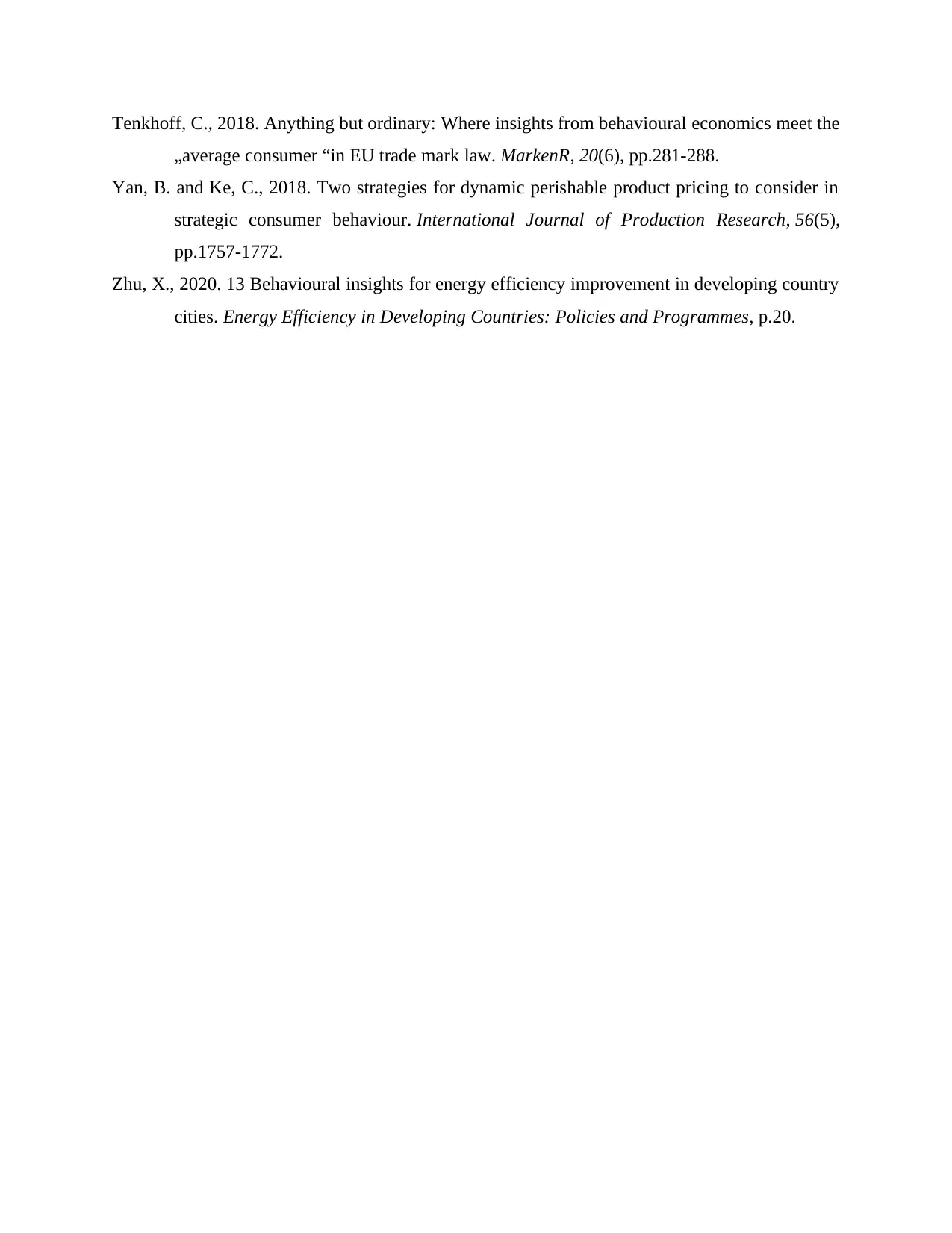
Tenkhoff, C., 2018. Anything but ordinary: Where insights from behavioural economics meet the
„average consumer “in EU trade mark law. MarkenR, 20(6), pp.281-288.
Yan, B. and Ke, C., 2018. Two strategies for dynamic perishable product pricing to consider in
strategic consumer behaviour. International Journal of Production Research, 56(5),
pp.1757-1772.
Zhu, X., 2020. 13 Behavioural insights for energy efficiency improvement in developing country
cities. Energy Efficiency in Developing Countries: Policies and Programmes, p.20.
„average consumer “in EU trade mark law. MarkenR, 20(6), pp.281-288.
Yan, B. and Ke, C., 2018. Two strategies for dynamic perishable product pricing to consider in
strategic consumer behaviour. International Journal of Production Research, 56(5),
pp.1757-1772.
Zhu, X., 2020. 13 Behavioural insights for energy efficiency improvement in developing country
cities. Energy Efficiency in Developing Countries: Policies and Programmes, p.20.

⊘ This is a preview!⊘
Do you want full access?
Subscribe today to unlock all pages.

Trusted by 1+ million students worldwide
1 out of 15
Related Documents
Your All-in-One AI-Powered Toolkit for Academic Success.
+13062052269
info@desklib.com
Available 24*7 on WhatsApp / Email
![[object Object]](/_next/static/media/star-bottom.7253800d.svg)
Unlock your academic potential
Copyright © 2020–2025 A2Z Services. All Rights Reserved. Developed and managed by ZUCOL.




